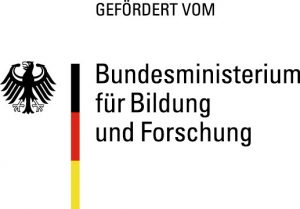
Forecasting of the Traffic Situation in the Hannover Region
The main requirement of road traffic participants is to know the current traffic situation. Such data is typically obtained from routing services where the time of many different individual trips is taken into account.
In the context of Data4UrbanMobility tools were developed that allow to predict the traffic situation based on such time series data. The following figure presents an interface to visualize typical time series patterns as well as outliers present in the data:

The prediction of the traffic situation is made available in the form of a map based interface for the end user:
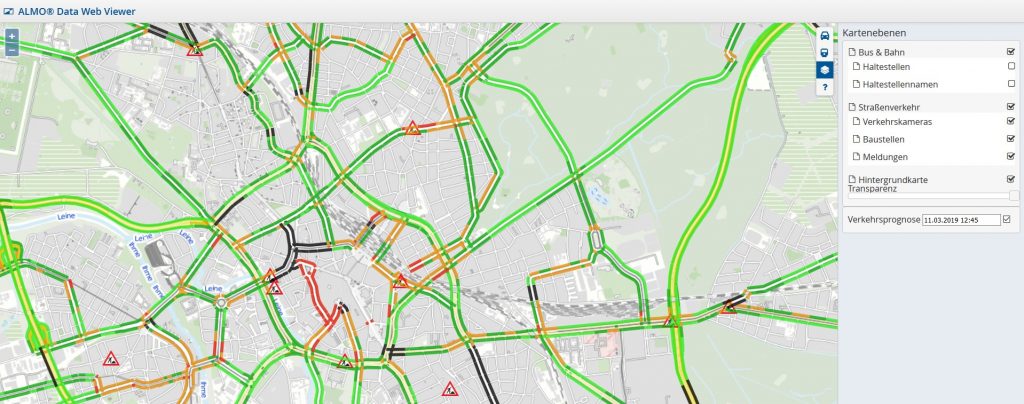
Data4UrbanMobility Data Protection Regulation
The work on the Data4UrbanMobility data protection regulation is completed. The document is publicly available and can be found here.
First Version of MiC-App Available
A first version of the novel MiC-App (Move in the City) App is now available for D4UM-associates as well as a protected group of public users. The mobile MiC-App is a tool to gather data.
MiC was developed by the Institute for Sustainable Urbanism at the University of Braunschweig and the Projektionisten GmbH. MiC links the growing awareness of digital citizen rights with the potential of evaluation big datasets. Therefore MiC gives the opportunity to citizen to actively participate in a citizen science project to take part in the development of the mobility of the feature.
MiC gathers data of the users movement, where the user has the about which data should be recorded. All data is pseudonymised such that the privacy of the contributing citizen is ensured.
Current Status:
In the first version of the app, the user can easily start and end the tracking of his/her movement. It is worth to point out, that the user decides when he is tracked and when not. A summary of his/her activity is available for the user as well as the opportunity to issue feedback or even delete all of his contributed data.
Updated System with Dashboard V2
With the new version of our system, the dashboard will provide even more insights into the impact of public events on the traffic situation.

The coloring and labels let us easily distinguish between the different type of events. By clicking on the label we show the typically affected subgraph for that event type. This allows the user to check what specific routes are typically affected by an event at that location.
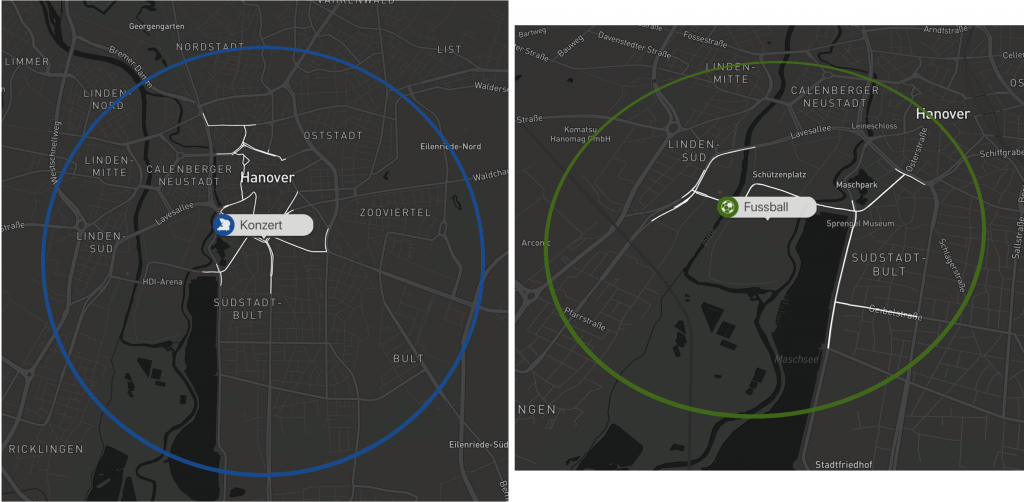
Examples: Visualisation of a concert and a football game.
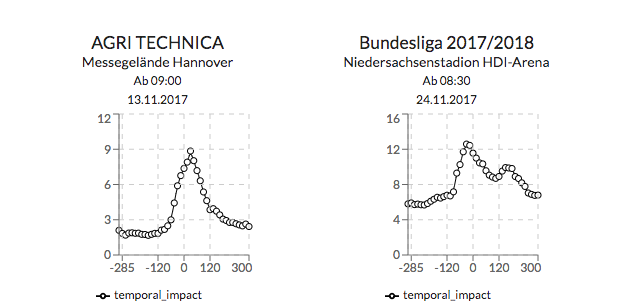
In addition, the graph at the top right gives additional information on how big the impact around the events start time tends to be.
{API}
We enriched the api endpoints with additional information from the data models that were developed as part of the research efforts.
D4UM App Version 1.0
We just released the first Version of the D4UM App. Every project member now has access to the application and can try out its features. Let’s quickly go over some of its main features.
The EFA integration (EFA is a routing engine covering Lower Saxony and Bremen ) allows for quick access to tip information using all available public transport options. Our focus, when designing the application, was on quick and easy navigation to provide a simple and easy to use trip planning tool.
Departures and Connections
On the departure screen we show the user the closes stops for public transportation in his immediate vicinity. On the connection screen the user can fill in his desired starting location( either an address or an existing stop ) and destination and query for what connections are available to him. The provided information contains real time data , meaning we are able to visualized delays for any given connection.
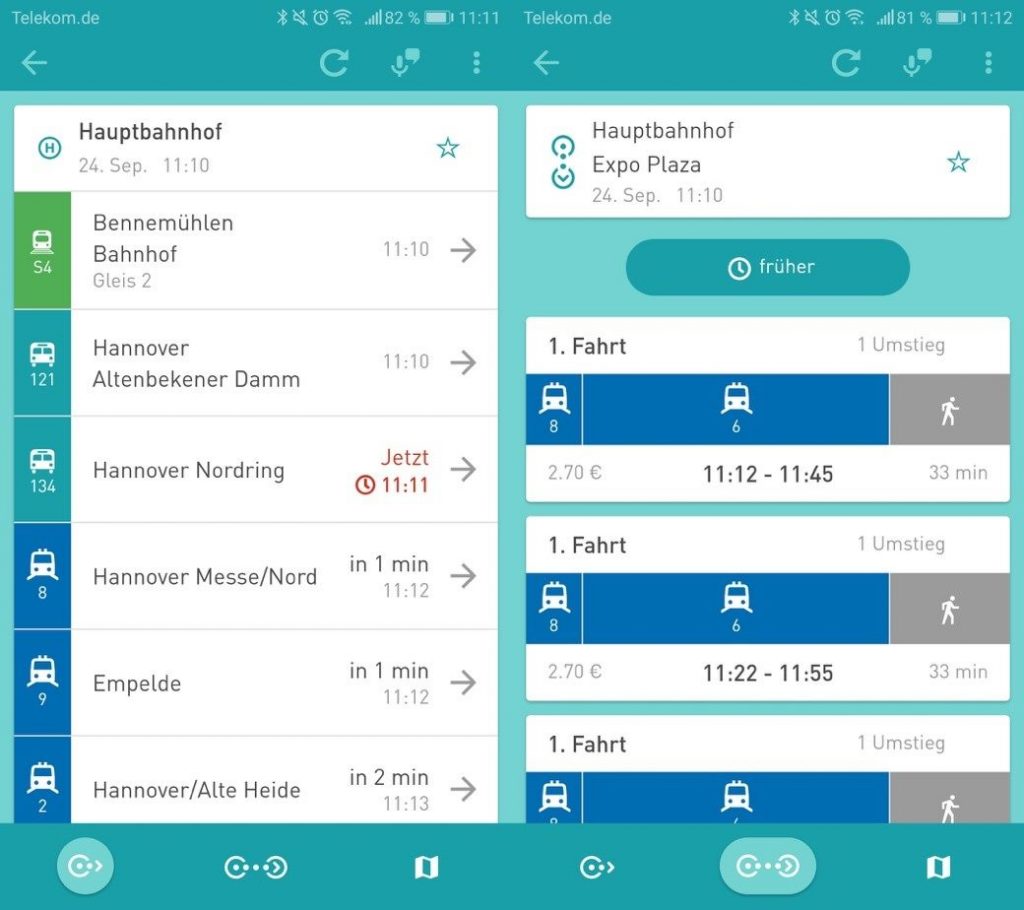
Map
On the map screen you can see and or find all available stops of public transportation. This allows for providing the user with a great way to find out what stops are available in their city. By clicking on any of the shown stops will open the departure screen and provide you with the information mentioned above. To better visualize a selected connection, we show the route you plan to travel on the map.
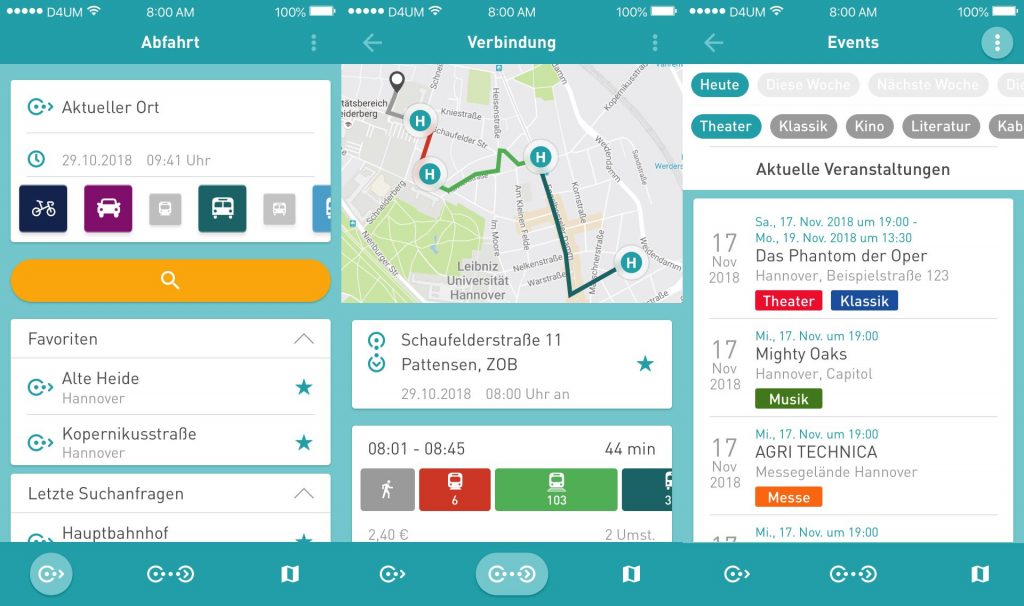
Menu / Settings
Additional features can be found in the settings menu of the application. Here you can find settings that allow you to customize your routing results for both the departures and connection screen. The best way to let us know what you think about the application is to use the feedback module. This can be found here as well. First click on the emoji that best describe how you feel about the app. And then put in any additional information or ideas or thoughts you may have. Now what is left is just to press send and you will send us an email.
We look forward to hearing from you.
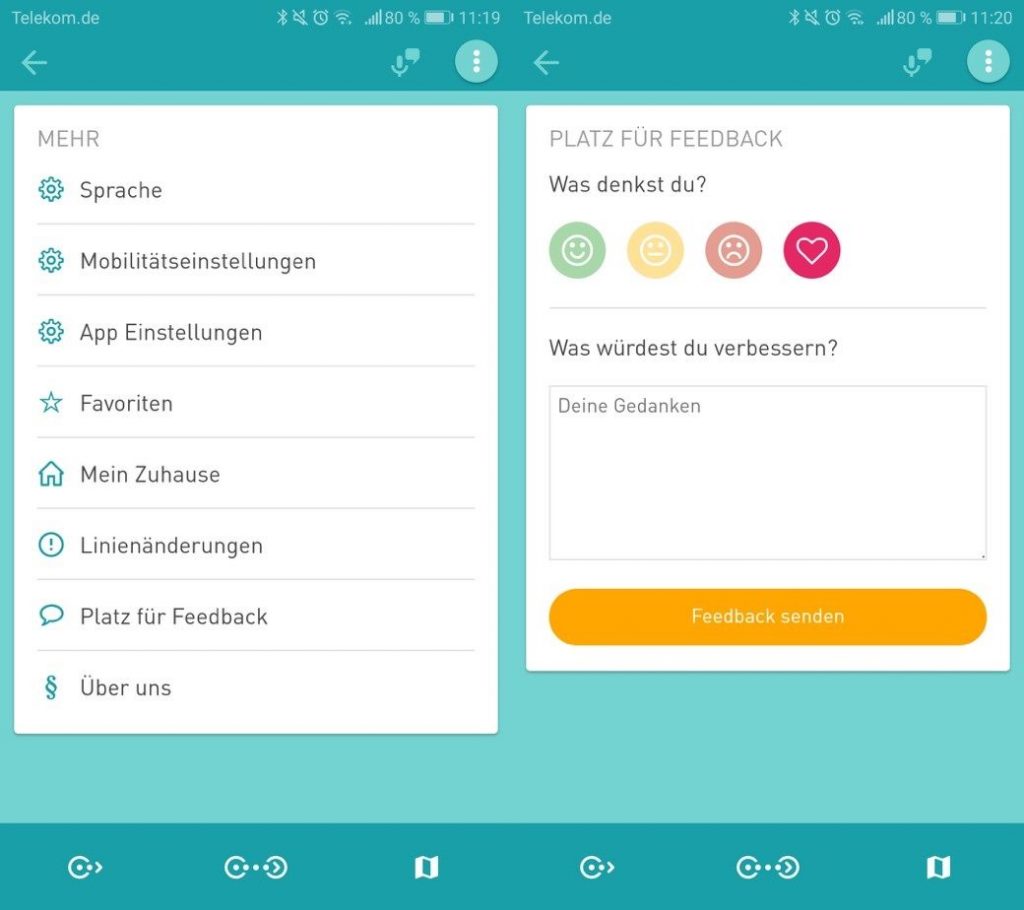
Quantification and Prediction of Impact of Public Events
Current Data4UrbanMobility research results allow for measuring and prediction of spatial impact on road traffic of public events. Connected, affected street segments nearby public events are identified to measure the spatial impact. The approach is depicted in the following figure:
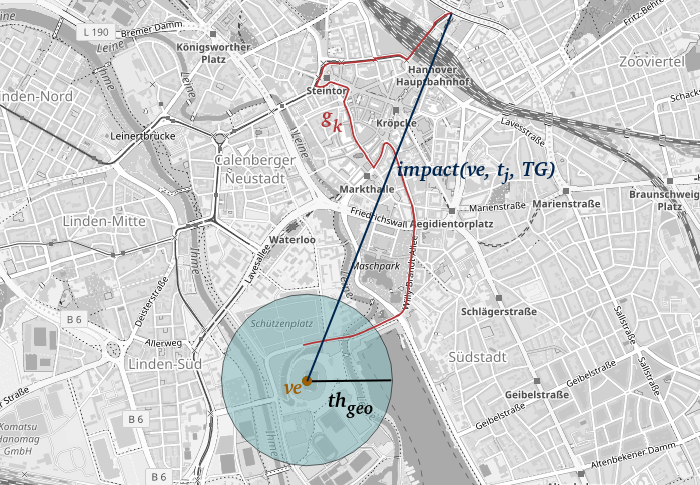
(Karte von https://www.openstreetmap.org)
An event is marked as yellow dot, affected streets in red and the measured impact in dark blue. Moreover, an approach making use of machine learning algorithms was developed to predict the impact determined in this way, resulting an error-reduction of up to 40% when compared to existing state-of-the-art approaches.
D4UM – Platform V1 Released
The first version of the Data4UrbanMobiltiy platform has been released. The platform was designed and implemented following a 3-tier-architecture. The platform provides RESTfull Web services for mobility applications like dashboards or mobile apps. As a demonstration, an interactive map application has been developed that visualizes the spatial impact of public events. The following figure shows a screenshot of the application.
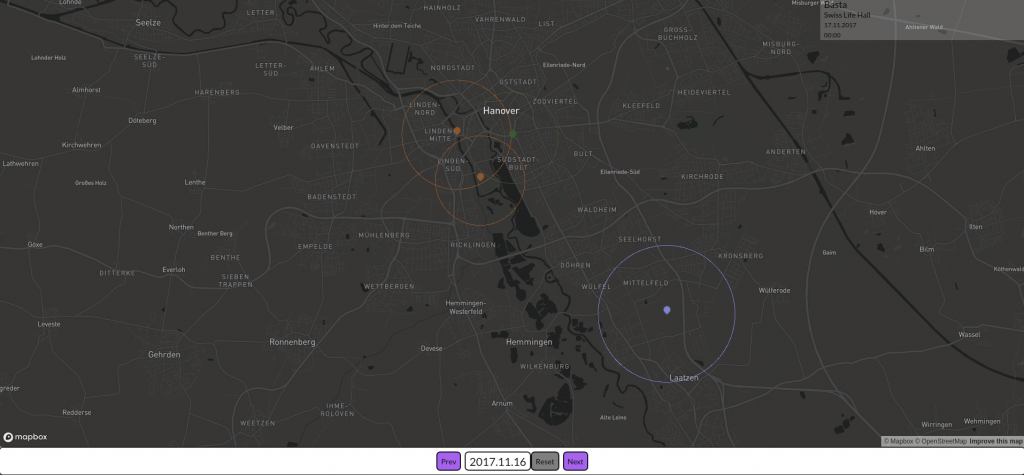
The figure shows 4 public events in the city of Hannover. The colors represent different types of public events (e.g. concerts, fairs, sport events). The circles visualize the spatial impact on road traffic caused by the public events.
Comprehensive Set of Requirements
The Data4UrbanMobility analysis of requirements includes requirements of the application partners Region Hannover (RH) and Wolfsburg AG (WAG) as well as non functional requirements. The requirements were collected by MOMA. The L3S derived research question for data analysis which are based on the requirements of RH and WAG. The research question address especially the information needs of end-users.
The current research questions particularly include
- Automated verification of traffic warnings and prediction of their impact
- Identification of events and prediction of their impact
- Investigation of correlation of road traffic data, public transportation query logs, traffic warnings and twitterfeeds
- Determination of optimal traveling timepoints
Growing Data Collection
ISU create a comprehensive data matrix containing potential source of mobility related data. The Data4UrbanMobility data model describes all project relevant data sets and sets them into context. This makes the data available in a unified manor for both analysis and applications. The selected data sources were transformed according to the Data4UrbanMobility data model by L3S. The data quality of selected data sources (i.e. public transportation query logs and road traffic data) was examined.
Tools for extracting the relevant information from the datasets were developed to enable the integration of the datasets.
- Street and graph extraction from OpenStreetMap
- Bulkloader for public transportation queries
- Integration of “Zentrales Haltestellen Verzeichniss” (central registry of public transportation stops)
The current collection (December 12th 2017) contians
EFA-Logs: 17 million public transportation queries
Road traffic data: 174 thousand street sements with a frequency of 15 minutes
GTFS-data: 90 thousand. public transportation stops, 2.6 thousand routes
Weather: Radolan “Regenraster” (rain grid)
Twitter: 2,5 Mio. Tweets starting at June 2017
OSM: 440 thousand streets
Events: 21 thousand public events (August 14th 2016-July 17th 2018)
Traffic warnings: 13 thousand warning (since June 2017)
Visualization of Public Transportation Information
In order to allow intuitive analytics of public transportation information, the PROJEKTIONISTEN (PROJ) developed a dashboard web application. First prototypes visualize queries addressed to the regional timetable information system EFA (www.efa.de). The prototypes serve as foundations for exploration analyses as well as the implementation of future versions of the dashboard. The following figure shows an integrated visualization of the most frequent origins and destinations of the queries.
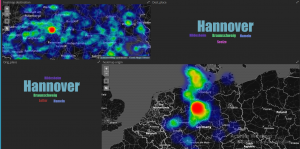
Analysen der EFA-Logs
Analysis of EFA Public Transportation Query Logs
Analyses regarding the impact of public events on public transportation are currently conducted to address early research questions. To this extend, explorative data analyses of the impact of major public events such as football games and medium sized events such as concerts were conducted. Visual analytics were used as a first step towards comprehensive analyses, which show start-like patterns for city center which identify mobility hubs of central importance.
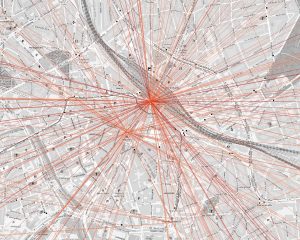
The figure shows the direct connection between origin and destination of public transportation queries. Darker colors correspond to more frequent queried trips. Star-like pattern identify the central train station and the central metro station.
Analyses of single stations reveal weekday dependent patterns.
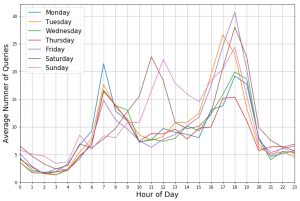
The figure depicts the average number of queries with the destination “Hannover Stadionbrücke”. Differences emerge between Weekends and workdays.
The impact of public events on the queries can be visualized as well.
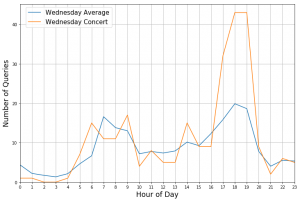
The figure shows the number of queries with the Destination “Hannover Stadionbrücke” for Wednesday, April 26th 2017 (orange) as well as the average number of queries on a Wednesday for the same destination. On this day a concert took place in venue nearby. The concert start at 8 pm. The significant deviations between 5 pm and 7 pm is highly likely to be caused by visitors of the concert. This shows that public transportation queries are a valuable information source to investigate the impact of public events on mobility infrastructure.
- Towards ML System Extensibility. Deng, Weixin; Ruan, Andy; Frisella, Megan; Chen, Kai-Hsun; Cho, SangBin; Humphries, Jack Tigar; Qiao, Rui; Wang, Stephanie (2025). 119–126.
- Fusion of GNN and GBDT Models for Graph and Node Classification. Farhan, Muhammad; Kajla, Nadeem Iqbal; Awan, Malik Daler Ali; Coustaty, Mickaël; Luqman, Muhammad Muzzamil; Bakkali, Souhail in Lecture Notes in Computer Science, L. Brun, V. Carletti, S. Bougleux, B. Gaüzère (eds.) (2025). (Vol. 15727) 167–178.
- Understanding Multidimensional Determinants of Information Security Policy Compliance in Hybrid Work Environments. Abdullah, Rafae Muhammad; Torres, Carlos I.; Carlson, John C. K. Riemenschneider, Y. W. Sullivan, M. Dinger, M. Bantan, N. Roberts (eds.) (2025). 18:1–18:2.
- How can information systems be designed to balance misinformation prevention with user privacy and freedom of expression on social media platforms. Alohali, Mansor; Alourani, Abdullah C. K. Riemenschneider, Y. W. Sullivan, M. Dinger, M. Bantan, N. Roberts (eds.) (2025). 4:1–4:2.
- Building Patient Trust in AI Healthcare Agents: Factors Influencing Acceptance and Adoption. Jing, Na C. K. Riemenschneider, Y. W. Sullivan, M. Dinger, M. Bantan, N. Roberts (eds.) (2025). 25:1.
- Evaluating Phishing Email Efficacy. Olea, Carlos; Christensen, Alexander; Fazio, Lisa; Cutting, Laurie; Lieb, Maxwell; Phelan, Jessica; Wise, Alyssa; Tucker, Holly C. K. Riemenschneider, Y. W. Sullivan, M. Dinger, M. Bantan, N. Roberts (eds.) (2025). 7:1–7:8.
- Feature Alignment in Vision Mamba to Resolve Domain Shift of Mobile Medical Devices. Shin, Jin; Kim, Hyun (2025). 1–4.
- A Geometric Perspective on Graph Similarity Learning Using Convex Hulls. Dobler, Kalvin; Riesen, Kaspar in Lecture Notes in Computer Science, L. Brun, V. Carletti, S. Bougleux, B. Gaüzère (eds.) (2025). (Vol. 15727) 103–112.
- Graph Neural Network Based on Molecular and Pharmacophoric Features for Drug Design Applications. Azevedo, Mariana; Brun, Luc; Héroux, Pierre; Lamotte, Jean Luc; Bureau, Ronan; Lepailleur, Alban in Lecture Notes in Computer Science, L. Brun, V. Carletti, S. Bougleux, B. Gaüzère (eds.) (2025). (Vol. 15727) 47–57.
- VisHubGAT: Visible Connectivity and Hub Nodes for Multimodal Entity Extraction. Telnoff, Quentin; Baitu, Baglan; Coustaty, Mickaël; Crohas, Fabrice; Doucet, Antoine in Lecture Notes in Computer Science, L. Brun, V. Carletti, S. Bougleux, B. Gaüzère (eds.) (2025). (Vol. 15727) 267–276.
- Exploring a Graph Regression Problem in River Networks. Fankhauser, Benjamin; Bigler, Vidushi; Riesen, Kaspar in Lecture Notes in Computer Science, L. Brun, V. Carletti, S. Bougleux, B. Gaüzère (eds.) (2025). (Vol. 15727) 203–213.
- Beyond Technical Training: A Cybersecurity Skills Framework for Non-Professionals. Schramm, Lena Theodora; Lin, Raymund; Wei, Hsiao-Lan C. K. Riemenschneider, Y. W. Sullivan, M. Dinger, M. Bantan, N. Roberts (eds.) (2025). 14:1–14:8.
- Lifting Some Secrets About Contrast Pyramids. Kropatsch, Walter G. in Lecture Notes in Computer Science, L. Brun, V. Carletti, S. Bougleux, B. Gaüzère (eds.) (2025). (Vol. 15727) 235–245.
- Gene Co-expression Networks are Poor Proxies for Expert-Curated Gene Regulatory Networks. Sarkar, Suryadipto; Blumenthal, David B. in Lecture Notes in Computer Science, L. Brun, V. Carletti, S. Bougleux, B. Gaüzère (eds.) (2025). (Vol. 15727) 37–46.
- Fully Randomized Pointers. Phaye, Sai Dhawal; Duck, Gregory J.; Yap, Roland H. C.; Carlson, Trevor E. M. Maas, T. Harris, O. Mutlu (eds.) (2025). 94–108.
- Reworking Memory Management in CRuby: A Practitioner Report. Wang, Kunshan; Blackburn, Stephen M.; Zhu, Peter; Valentine-House, Matthew M. Maas, T. Harris, O. Mutlu (eds.) (2025). 109–121.
- Reconsidering Garbage Collection in Julia: A Practitioner Report. de Souza Amorim, Luís Eduardo; Lin, Yi; Blackburn, Stephen M.; Netto, Diogo; Baraldi, Gabriel; Daly, Nathan; Hosking, Antony L.; Pamnany, Kiran; Smith, Oscar M. Maas, T. Harris, O. Mutlu (eds.) (2025). 72–83.
- Artificial Intelligence and Machine Learning Based Plant Monitoring. Rampure, Shrutika C; P, Bhavyashree S; T, Rakshitha B (2025).
- Compiler-Assisted Crash Consistency for PMEM. Soh, Yun Joon; Liu, Sihang; Swanson, Steven; Zhao, Jishen M. Maas, T. Harris, O. Mutlu (eds.) (2025). 41–55.
- SecureMind: A Framework for Benchmarking Large Language Models in Memory Bug Detection and Repair. Wang, Huanting; Jacob, Dejice; Kelly, David; Elkhatib, Yehia; Singer, Jeremy; Wang, Zheng M. Maas, T. Harris, O. Mutlu (eds.) (2025). 27–40.
- Cyber Defense through Agentic AI Enabled Automation: An Approach to Reduce Cyber Risk. Vajpayee, Prashant; Hossain, Gahangir C. K. Riemenschneider, Y. W. Sullivan, M. Dinger, M. Bantan, N. Roberts (eds.) (2025). 9:1–9:2.
- Differential Well-Being Outcomes from Smart Device Adoption: A Comparative Analysis of Seniors and Non-Seniors. Liu, Dapeng; Liu, Jinyu; Song, Xinru; Saxena, Tejaswi C. K. Riemenschneider, Y. W. Sullivan, M. Dinger, M. Bantan, N. Roberts (eds.) (2025). 19:1–19:7.
- Arborescent Garbage Collection: A Dynamic Graph Approach to Immediate Cycle Collection. Lahaie-Bertrand, Frédéric; O’Leary, Léonard Oest; Melançon, Olivier; Feeley, Marc; Monnier, Stefan M. Maas, T. Harris, O. Mutlu (eds.) (2025). 14–26.
- Tolerate It if You Cannot Reduce It: Handling Latency in Tiered Memory. Unal, Musa; Gupta, Vishal; Pan, Yueyang; Ren, Yujie; Kashyap, Sanidhya (2025). 50–57.
- Leveraging Software Fault Tolerance for Longer Flash Hardware Lifespan. Zuck, Aviad; Johnson, Rob; Porter, Donald E.; Tsafrir, Dan (2025). 210–217.
- Modular, Full-System Verification. Malecha, Gregory; Dang, Hoang-Hai; Giarrusso, Paolo G.; Hudon, Simon; Kaiser, Jan-Oliver; Swasey, David (2025). 42–49.
- Rethinking Tiered Storage: Talk to File Systems, Not Device Drivers. Zhang, Jiyuan; Kim, Jongyul; Alverti, Chloe; Liu, Peizhe; Jia, Weiwei; Xu, Tianyin (2025). 67–73.
- Guillotine: Hypervisors for Isolating Malicious AIs. Mickens, James; Radway, Sarah; Netravali, Ravi (2025). 18–26.
- The NIC should be part of the OS. Xu, Pengcheng; Roscoe, Timothy (2025). 151–157.
- Granular Resource Demand Heterogeneity. Liang, Yizhuo; Govindan, Ramesh; Park, Seo Jin (2025). 187–194.
- Stop Taking the Scenic Route: the Shortest Distance Between the CPU and the NIC is MMIO. Liew, Wei Siew; Rahaman, Md Ashfaqur; McMahon, James; Stutsman, Ryan; Nagarajan, Vijay (2025). 144–150.
- Understanding the limitations of pubsub systems. Adya, Atul; Bogle, Phil; Meek, Colin (2025). 165–171.
- Analyzing Metastable Failures. Isaacs, Rebecca; Alvaro, Peter; Majumdar, Rupak; Kumar, Kiran; Reddy, Muniswamy; Salamati, Mahmoud; Soudjani, Sadegh (2025). 172–178.
- How Human Behavior Can Mitigate AI-Generated Cybersecurity Threats. Noordeen, Abdul Rahman; Bantan, May C. K. Riemenschneider, Y. W. Sullivan, M. Dinger, M. Bantan, N. Roberts (eds.) (2025). 17:1–17:3.
- The Case for Energy Clarity. Chung, Fan; Kuo, Henry; Candea, George (2025). 202–209.
- Towards Resource-Efficient Compound AI Systems. Chaudhry, Gohar Irfan; Choukse, Esha; Goiri, Íñigo; Fonseca, Rodrigo; Belay, Adam; Bianchini, Ricardo (2025). 218–224.
- Panel: Workforce Implications of Learned passivity. Slyke, Craig Van; Mansour, Joseph; Joseph, Damien; Sumner, Mary; Zaza, Sam C. K. Riemenschneider, Y. W. Sullivan, M. Dinger, M. Bantan, N. Roberts (eds.) (2025). 26:1–26:2.
- On the Attitudes of GameDev Industry Artists towards GenAI. Preliminary Results. Sikorski, Lukasz; Matulewski, Jacek; Czerwonka, Malgorzata C. K. Riemenschneider, Y. W. Sullivan, M. Dinger, M. Bantan, N. Roberts (eds.) (2025). 2:1–2:6.
- Software as a Service (SaaS) and Firm Performance: The Necessity of Differentiating between Vertical and Horizontal SaaS. Shapouri, Fatemeh; Ward, Kerry; Lumbard, Kevin; Setor, Tenace C. K. Riemenschneider, Y. W. Sullivan, M. Dinger, M. Bantan, N. Roberts (eds.) (2025). 12:1–12:7.
- Unleashing the Machine : Exploring the Dual Power of AI’s Agentic Behavior and Anthropomorphic Design in an Agents Decision-Making. Pallepogu, Jayabhushan Praneeth; Gupta, Saurabh C. K. Riemenschneider, Y. W. Sullivan, M. Dinger, M. Bantan, N. Roberts (eds.) (2025). 11:1–11:2.
- "Not My First Choice": Why Software Testing Struggles to Attract Early-Career Professionals. Mulgund, Pavankumar; Singh, Raghvendra; Gillenson, Mark; Li, Yafang; Oliver, Carol C. K. Riemenschneider, Y. W. Sullivan, M. Dinger, M. Bantan, N. Roberts (eds.) (2025). 13:1–13:8.
- Gender Disparities in STEM Education and Academia: an Open Data Approach from Bolivia. Jiménez, Elizabeth; Guzman, Indira R.; Lens, Alexandro Israel C. K. Riemenschneider, Y. W. Sullivan, M. Dinger, M. Bantan, N. Roberts (eds.) (2025). 21:1–21:2.
- Financial Inclusion in a Cashless Society: Moderating a Darkside of Cashless Societies. Abayomi, Olushola; Noordeen, Abdul Rahman C. K. Riemenschneider, Y. W. Sullivan, M. Dinger, M. Bantan, N. Roberts (eds.) (2025). 16:1–16:3.
- EMD: Fair and Efficient Dynamic Memory De-bloating of Transparent Huge Pages. Gangar, Parth; Panwar, Ashish; Gopinath, K. M. Maas, T. Harris, O. Mutlu (eds.) (2025). 1–13.
- TierTrain: Proactive Memory Tiering for CPU-Based DNN Training. Swaminathan, Sathvik; Kumar, Sandeep; Prasad, Aravinda; Subramoney, Sreenivas M. Maas, T. Harris, O. Mutlu (eds.) (2025). 56–71.
- Gray-in-Young: A Generational Garbage Collection for Processing-in-Memory. Morimoto, Ryu; Ichinose, Kazuki; Ugawa, Tomoharu M. Maas, T. Harris, O. Mutlu (eds.) (2025). 122–133.
- Time-critical and confidence-based abstraction dropping methods. Schmöcker, Lennart Kampmann Robin (2025).
- Protection Against Poisoning Attacks on Federated Learning-Based Spectrum Sensing \($\$\) \($ \lg $\)\\($ $\). Wasilewska, Malgorzata; Bogucka, Hanna (2025).
- Leveraging Large Language Models for Automated Definition Extraction with TaxoMatic A Case Study on Media Bias. Spinde, Timo; Lin, Luyang; Hinterreiter, Smi; Echizen, Isao (2025). (Vol. 19)
- NewsUnfold: Creating a News-Reading Application That Indicates Linguistic Media Bias and Collects Feedback. Hinterreiter, Smi; Wessel, Martin Paul; Schliski, Fabian; Echizen, Isao; Latoschik, Marc Erich; Spinde, Timo J. An, Y.-R. Lin, Y. Mejova, E. Mustafaraj, J. Kulshrestha, I. Weber (eds.) (2025). 804–822.
- Heat Storage Pattern Linked to the Atlantic Meridional Overturning Circulation Slowdown. Ren, Qiuping; Li, Yuanlong; Hu, Shineng; Xie, Shang-Ping; Lyu, Yilong; Wang, Fan (2025). 52(13) e2025GL116801.
- VIA-VR: A Platform to Streamline the Development of Virtual Reality Serious Games for Healthcare. Truman, Samuel; Von Mammen, Sebastian (2025). 463–468.
- VIA-VR: A Platform to Streamline the Development of Virtual Reality Serious Games for Healthcare. Truman, Samuel; Von Mammen, Sebastian (2025). 463–468.
- Aggregation-Free Uncertainty Estimation for CTC-Based Automatic Speech Recognition. Rumberg, Lars; Gebauer, Christopher; Ostermann, Jörn (2025).
- A Survey of Non-Learning-Based Abstractions for Sequential Decision-Making. Schmöcker, Robin; Dockhorn, Alexander (2025). 13 100808–100830.
- Cascade - A sequential ensemble method for continuous control tasks. Schmöcker, Robin; Dockhorn, Alexander (2025).
- Cell Tracking according to Biological Needs - Strong Mitosis-aware Multi-Hypothesis Tracker with Aleatoric Uncertainty. Kaiser, Timo; Schier, Maximilian; Rosenhahn, Bodo (2025).
- Pruning by Block Benefit: Exploring the Properties of Vision Transformer Blocks during Domain Adaptation. Glandorf, Patrick; Bodo, Rosenhahn (2025).
- VaMEx3-MarsSymphony: Technology Demonstration for Martian exploration swarm robotics. Riegler, Clemens; Kayal, Hakan; Maurer, Andreas; Mutter, Julian; Neuhaus, Lennart; Stadler, Joshua (2025).
- The Resound Sphere: Co-Exploring Alternatives for Community Remote Practice of Faith. Wolf, Sara; Chatting, David; Morris, Ben; Claisse, Caro; Durrant, Abigail C. (2025).
- The Resound Sphere: Co-Exploring Alternatives for Community Remote Practice of Faith. Wolf, Sara; Chatting, David; Morris, Ben; Claisse, Caro; Durrant, Abigail C. (2025).
- Assessment of Abrupt Shifts in CMIP6 Models Using Edge Detection. Terpstra, Sjoerd; Falkena, Swinda K. J.; Bastiaansen, Robbin; Bathiany, Sebastian; Dijkstra, Henk A.; von der Heydt, Anna S. (2025). 6(3) e2025AV001698.
- VR Cybersickness Classification using Machine Learning Models on Open-Access EEG Datasets from the Human Vestibular Network. Li, Gang; Byeon, Hae-Rin; Cho, Sung-Bae; Pollick, Frank E. (2025). 171–175.
- Low-Constraint Ray Optimization for Photogrammetric Shallow Water Bathymetry. Liebender, C.; Meyer, P.; Bleier, M.; Nüchter, A. in The International Archives of the Photogrammetry, Remote Sensing and Spatial Information Sciences, XLVIII-2/W10-2025 (2025). 163–168.
- Robustness of Question Answering Systems in the Biomedical Domain: a study of the BioASQ dataset. Reeves, Andrew; Dong, Hang (2025). 247–252.
- Steamboat: Attention-Based Multiscale Delineation of Cellular Interactions in Tissues. Liang, Shaoheng; Tang, Junjie; Wang, Guanghan; Ma, Jian in Lecture Notes in Computer Science, S. Sankararaman (ed.) (2025). (Vol. 15647) 432–436.
- Unified Integration of Spatial Transcriptomics Across Platforms. Haber, Ellie; Deshpande, Ajinkya; Ma, Jian; Krieger, Spencer in Lecture Notes in Computer Science, S. Sankararaman (ed.) (2025). (Vol. 15647) 371–375.
- Applying Cfahp to Explore the Key Models of Semiconductor Pre-Sales. Kao, Fei-Hon; Hsieh, Chia-Hsiang; Pei, Wen in Frontiers in Artificial Intelligence and Applications, R. Mizoguchi, P. Dillenbourg, Z. Zhu (eds.) (2025). (Vol. 151) 149–156.
- Transparent Ransomware Detection in Bitcoin Transactions: Leveraging Machine Learning and Explainable AI. Mohammed, Roshan; Rezvy, Shahadate (2024). 1–5.
- News Ninja: Gamified Annotation of Linguistic Bias in Online News. Hinterreiter, Smi; Spinde, Timo; Oberdörfer, Sebastian; Echizen, Isao; Latoschik, Marc Erich (2024). 8(CHI PLAY, Article 327)
- Exploring the Feasibility of Virtual Reality in Post-Stroke Rehabilitation: Medical Perspectives on Motion Health VR. Castillo, Julian Felipe Villada; López, Jose Fernando; Muñoz, John Edison; Gallo, Oscar Henao in Communications in Computer and Information Science, V. A. Delgado, P. H. Ruiz, C. A. M. Escobar (eds.) (2024). (Vol. 2332) 144–158.
- A Methodological Overview About Hand Tracking and Cognitive Influences in Virtual Reality. Madrigal, Omar Correa; Muhamethanov, Ilnur Radikovich; Vladimirovna, Vlada Kugurakova in Communications in Computer and Information Science, V. A. Delgado, P. H. Ruiz, C. A. M. Escobar (eds.) (2024). (Vol. 2332) 14–24.
- Characterization of Interactive Multimedia Experiences in Inclusive School Contexts Considering Learning Analytics. Beltrán, Paola A. Castillo; Alegría, Andrés Fernando Solano; Ayala, Carlos A. Peláez; Munar, Leonardo Saavedra; la Rosa Alzate, Emma A. De in Communications in Computer and Information Science, V. A. Delgado, P. H. Ruiz, C. A. M. Escobar (eds.) (2024). (Vol. 2332) 67–79.
- Evaluation Heuristics to Improve Usability in Ecommerce Platforms. Muñoz, Alejandra Yicel Vargas; Collazos, César A.; Granollers, Toni in Communications in Computer and Information Science, V. A. Delgado, P. H. Ruiz, C. A. M. Escobar (eds.) (2024). (Vol. 2332) 104–119.
- WiFi Channel State Information-based Motion Detection Across Time-Domain. Wang, Qinhong; Wu, Zhenhua (2024). 1–5.
- Real-Time Hardware Emulation for Spatial-Temporal Correlated Multiple Channels. Yang, Ling; Fang, Sheng; Zheng, Yongfeng; Xie, Yuetian; Ding, Yuan; Wang, Longjun; Hua, Boyu; Zhu, Qiuming (2024). 1441–1445.
- Performance Evaluation of Novel Photon-Counting Micro-CT System for Preclinical Spectral Imaging and its Applications. Xue, Mengjia; Liu, Qian; Xie, Tianwu (2024). 1–6.
- Exploring Accessibility: The First Interaction of Visually Impaired Users with the UNAD Virtual Campus. Puerto, Lina Mercedes Lozano; M, Gustavo E. Constaín; Barbero, Jonathan Chacón in Communications in Computer and Information Science, V. A. Delgado, P. H. Ruiz, C. A. M. Escobar (eds.) (2024). (Vol. 2332) 129–143.
- Writing UX Requirements in Acceptance Criteria: A Case Study in Startups. Souza, Jonathan; Zaina, Luciana in Communications in Computer and Information Science, V. A. Delgado, P. H. Ruiz, C. A. M. Escobar (eds.) (2024). (Vol. 2332) 340–353.
- Measure of Coolness on the Blind User Experience. de Sousa Santana, Rosangela Divina; Ferreira, Deller James; de Oliveira Berreta, Luciana in Communications in Computer and Information Science, V. A. Delgado, P. H. Ruiz, C. A. M. Escobar (eds.) (2024). (Vol. 2332) 228–241.
- SME Users in Industry 4.0. Study of the Metalworking Industry in Argentina. Mon, Alicia; Giorgio, Horacio René Del; Roark, Geraldina Yesica; Sueldo, Carolina Saavedra; Colo, Ivo Perez; Paula, Mariano De in Communications in Computer and Information Science, V. A. Delgado, P. H. Ruiz, C. A. M. Escobar (eds.) (2024). (Vol. 2332) 281–295.
- VNExpirationDate: A Novel Expiration Date Dataset and a Robust Framework for Expiration Date Recognition on Complex Packaging in Vietnam. Tien, Le-Thanh; Hien, Hua-Nguyen-Minh; Ny, Hoang-Thi-Xuan; An, Nguyen-Huu; Quang, Dung-Cam (2024). 388–392.
- Enhancing URL Classification with Hyperparameter-Tuned Convolutional Neural Networks. Tran, Thuy Thi; Phan, Nghia Quoc; Huynh, Hiep Xuan (2024). 409–413.
- A Novel Method for Wearable Activity Recognition with Feature Evolvable Streams. Wang, Yixiao; Hu, Chunyu; Liu, Hong; Lyu, Lei; Yuan, Lin in Lecture Notes of the Institute for Computer Sciences, Social Informatics and Telecommunications Engineering, A. B. Zaslavsky, Z. Ning, V. Kalogeraki, D. Georgakopoulos, P. K. Chrysanthis (eds.) (2023). (Vol. 593) 392–407.
- Secure Cloud Storage System for Digital Evidence. Malina, Lukas; Muzikant, Petr; Nohava, Martin; Hajny, Jan; Dufka, Antonín; Svenda, Petr; Stupka, Václav (2023). 134–139.
- Refined Fuzzy Profile Matching. Rácz, Gábor; Sali, Attila; Schewe, Klaus-Dieter (2023). 26(2) 243–266.
- FieldHAR: A Fully Integrated End-to-End RTL Framework for Human Activity Recognition with Neural Networks from Heterogeneous Sensors. Liu, Mengxi; Zhou, Bo; Zhao, Zimin; Hong, Hyeonseok; Kim, Hyun; Suh, Sungho; Rey, Vítor Fortes; Lukowicz, Paul (2023). 110–118.
- Random Location Poisoning Backdoor Attack Against Automatic Modulation Classification in Wireless Networks. Li, Zixin; Jiang, Hang; Zhang, Sicheng; Xiang, Wei; Lin, Yun (2023). 1–6.
- Multi-antenna covert communications in random wireless networks with full-duplex relay. Liu, Yan; Wu, Huihui; Shen, Yulong; Jiang, Xiaohong J. Hong, M. Bures, J. W. Park, T. Cerný (eds.) (2022). 1960–1966.
- A Gamified Approach To Automatically Detect Biased Wording And Train Critical Reading. Hinterreiter, Smi (2021).
- Game Theory Based Power Allocation Method for Inter-satellite Links in LEO/MEO Two-layered Satellite Networks. Zhang, Huaming; Li, Qiang; Zhang, Yijin; Li, Xun (2021). 398–403.
- Multi-modal Medical Image Fusion Based on GAN and the Shift-Invariant Shearlet Transform. Wang, Lei; Chang, Chunhong; Hao, Benli; Liu, Chunxiang T. Park, Y.-R. Cho, X. Hu, I. Yoo, H. G. Woo, J. Wang, J. C. Facelli, S. Nam, M. Kang (eds.) (2020). 2538–2543.
- Execution Time Prediction for Apache Spark. Gao, Zhipeng; Wang, Ting; Wang, Qian; Yang, Yang (2018). 47–51.
- Sorption properties of sodium bicarbonate. Walawska, Barbara; Szymanek, Arkadiusz; Pajdak, Anna; Nowak, Marzena; Hala, Bożena (2012). (Vol. 66) 1169–1176.
- Patterns for configuration requirements of Software-as-a-Service. Shim, Jaekeun; Han, Jongdae; Kim, Jindae; Lee, Byungjeong; Oh, Jaewon; Wu, Chisu W. C. Chu, W. E. Wong, M. J. Palakal, C.-C. Hung (eds.) (2011). 155–161.
- Service Forest: Enabling Dynamic Service Composition in Mobile Ad Hoc Networks. Huang, Jun; Bai, Yuebin; Zhang, Zhiyuan; Kong, Jing; Qian, Depei (2007). 174–177.
- Effects of capillary condensation on the caking of bulk sucrose. Billings, S.W.; Bronlund, J.E.; Paterson, A.H.J. (2006). 77(4) 887–895.
- Deriving Relation Keys from XML Keys. Wang, Qing; Wu, Hongwei; Xiao, Jianchang; Zhou, Aoying; Zhou, Junmei in CRPIT, K.-D. Schewe, X. Zhou (eds.) (2003). (Vol. 17) 227–235.
- Water activity in concentrated sucrose solutions and its consequences for the availability of water in the film of syrup surrounding the sugar crystal. Starzak, Maciej; Mathlouthi, Mohamed (2002). 127 175–185.
- The occult underground Webb, James (1988). Open Court, LaSalle, Ill.

